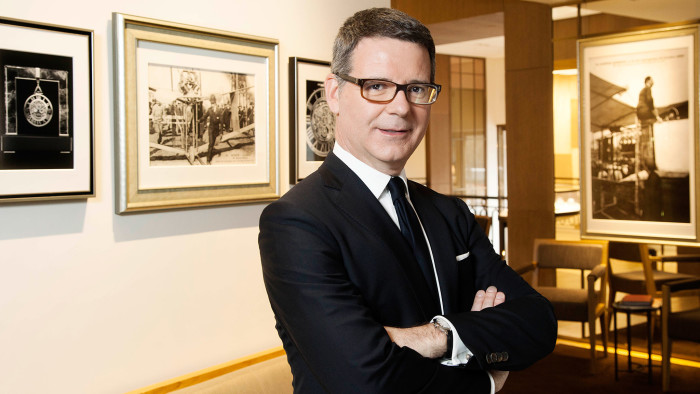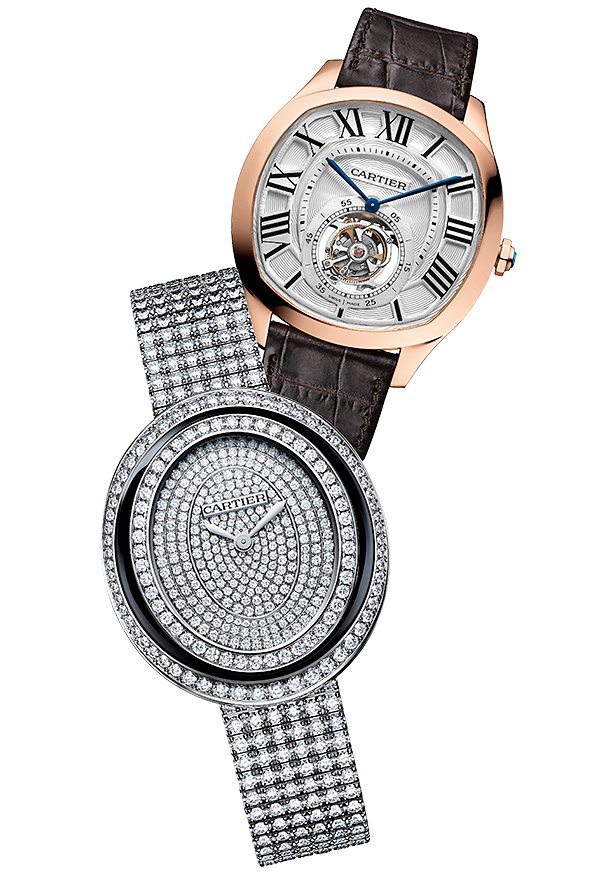Cartier launches new models even in industry downturn

Roula Khalaf, Editor of the FT, selects her favourite stories in this weekly newsletter.
While other Swiss watch brands are responding to the global downturn by paring back their collections and exploiting best-sellers, there is no such parsimony at Cartier, which this year has unveiled 83 pieces. “In this environment, distinctiveness is key,” says Pierre Rainero, director of image, style and heritage.
Cartier’s 2016 collection includes the Drive de Cartier, a cushion-shaped men’s watch, and Hypnose, an elliptical diamond-set watch for women — two original designs it hopes will shore up its foundations. At a time when most brands are peddling “consolidation” and “building on a core collection”, Cartier is sticking to its guns. “We have a tradition of coming to the market with a lot of new creations — we have our own rhythm and culture,” says Mr Rainero.
The luxury watch industry in Switzerland has seen two of its biggest markets shaken: exports to Hong Kong and China between January 2015 and April 2016 were down 28 per cent and 11 per cent respectively, a drop in total sales value of SFr721m ($727m), according to the Federation of the Swiss Watch Industry.
Meanwhile, the unpegging of the Swiss franc against the euro last year led to a rapid rise in its value, only partially reversed, which has undermined exports.
The worry for the industry is that it faces a painful tangle of factors. Anti-corruption moves in China, the threat of an unravelling Europe, currency fluctuations, crises in Syria and Ukraine and other problems besides have left some wondering if Swiss watchmaking is facing its biggest challenge since the quartz crisis of the 1970s.
In times of crisis, some brands retrench rapidly. Zenith was among the first, slashing hundreds of models at the end of the past decade.
Audemars Piguet did the same more recently, simultaneously taking the knife to its global retailer network. Yet François-Henry Bennahmias, chief executive of Audemars Piguet, announced in January that his brand’s turnover was up year-on-year.
Others have simply dropped their prices — TAG Heuer says its sales are climbing following a repositioning of its collection in 2015.

Not all companies are on board with this strategy of scaling back. Cartier has taken to introducing new models and ranges every year, confident new products will stimulate the market.
“We are present in more markets than any other house and we have many different types of clients,” says Mr Rainero. “It would be a reduction of what we are [to reduce the inventory]. We are conscious that this can create confusion — we have a masculine offer, a feminine offer, an accessible offer and an offer at the very top, all at the same time,” he continues. “But that’s the way Cartier is. We know it’s difficult to apprehend for most people, but that’s the way we are and the way we have always been.”
Mr Rainero maintains that introducing new models every year stimulates a market accustomed to buying more than one luxury watch. “It’s very rare to see someone buying a watch for their entire life,” he says.
While some would view a collection that includes the quartz-powered Tank Solo at £1,750 and the wildly complicated Rotonde de Cartier Grande Complication at £535,000 as unbalanced, Cartier sees it as a strength.
Despite being the world’s largest luxury watch and jewellery brand when ranked by combined sales — and a master of regeneration — the Parisian house is no stranger to the downturn. Cartier, like Rolex, has felt the impact of Chinese premier Xi Jinping’s clampdown on gifting while China’s economic slowdown has hurt, too.
In its half-year report published last November, Cartier’s parent company Richemont said there had been lower demand for its watches and that Asia-Pacific “posted a significant decline, primarily due to weakness in Hong Kong and Macau”, territories whose previous growth was underpinned by travelling Chinese. Group sales in the region were down 17 per cent year-on-year at constant exchange rates.
To lend weight to its new product strategy, last year Cartier introduced a glossy term to its marketing lexicon: “montres de forme”. Was it adopted so that when Cartier announced a new model, it was not simply a new watch but a new “form”?
“Exactly,” says Mr Rainero. “We have two fields of expression in our watches — pure shapes and expressive shapes. Expressive means you should very clearly identify the inspiration behind it, like the Crash [said to be inspired by a watch crushed in a car accident], or the Roadster of the early 2000s that took its inspiration from the car industry.”
The Drive de Cartier, by contrast, is merely “for the sake of a shape”, he says. “In the case of the Drive, you cannot associate it to something else.”
What is interesting about the Drive is that it is aimed solely at men. By comparison, last year’s invention, the Clé de Cartier, was unisex. With its fluid lines and curvaceous silhouette, it was too feminine for many men: Reuters reported at the end of 2015 that 90 per cent of sales had been to women.
Drive is the antidote, a more explicitly masculine design that buys Cartier some traction with a male audience that traditionally spends more on watches than the female equivalent.
Mr Rainero is also at pains to point out that Cartier’s new designs strengthen the codes, or signature features, that give its watches their distinctiveness.
“We were born with a sapphire cabochon,” he says. “That was in the Santos, a gift from Louis Cartier to [Brazilian pioneer aviator] Alberto Santos-Dumont in 1904. It was the first watch ever designed to be worn specifically on the wrist.”
In time came the sword-shaped hands, the rail track that can sit either inside or outside the numerals, the Roman numeral dials and the use of “IIII” at four o’clock, a tradition Mr Rainero says was picked up from 17th-century clocks. It is these tropes that make every new montre de forme a Cartier, he says, no matter the shape or the target audience.
Mr Rainero has been managing style at Cartier for almost two decades. Today, his responsibilities include “image” and “heritage”, two central pillars of a brand that has been making watches for more than a century and jewellery since 1847.
“If you’re responsible for style at Cartier, it presupposes that you have a certain knowledge of the heritage,” he says. “You cannot pretend to say this is the Cartier style without knowing about the tradition and the spirit behind the brand. It’s not only the facts, it’s the philosophy behind it.”
It is an allegiance to that philosophy that Cartier is banking on to help it ride out the current storm.
Comments